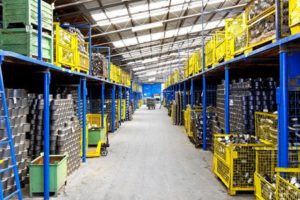How Technology Can Optimize Warehouse Efficiency
Blog: Apriso Blog
 Warehouses, much like any other competitive industry, are beginning to utilize emerging technologies in new and cost-effective ways. These technological breakthroughs make warehouses more efficient, safer and generally more sophisticated than the warehouses of the past.
Warehouses, much like any other competitive industry, are beginning to utilize emerging technologies in new and cost-effective ways. These technological breakthroughs make warehouses more efficient, safer and generally more sophisticated than the warehouses of the past.
The types of technology are varied and serve different purposes, so here are examples of some of the best technological developments being used in warehouses today.
Software Solutions
Not many types of businesses can expect to compete if they’re not utilizing software to help streamline their work. Warehouses are big beneficiaries of software, as the plethora of warehouse management systems makes life easy. The software helps track inventory, acts on orders and aids in just about anything else that needs to be monitored. The days of pen and paper are mercifully over. Warehouses can now use hand scanners, barcodes and other tools in order to improve efficiency.
Prices vary, and there are a number of different software solutions out there to choose from. If you’re not totally happy with the software you’re currently using, then and see if some better options are out there. Using the right software can have a big effect on the business. Just make sure you’ve tested the software before switching over to an entirely new system.
Smartly Tracking Equipment’s Condition
Monitoring equipment, whether it’s forklifts, conveyor belts or cranes, is a critical component for any warehouse. However, it’s also a time-consuming and labor-intensive process. Whether equipment is brand-new or purchased second-hand, many warehouses have begun digitally tracking the condition of their equipment.
Some businesses use QR codes that can be scanned by smartphones so that technicians can instantly see the equipment’s history and report back on any repairs conducted. This saves time and also ensures that potential problems don’t fall through the cracks or get lost in the paperwork shuffle. A system like that is especially important for ensuring the safety of the people using the equipment.
Automation in the Warehouses
The warehouses used by online retailer Amazon.com are so advanced that they’ve attracted mainstream attention from people who have likely never set a foot in a warehouse. What makes Amazon’s warehouses so interesting is their advanced use of automation to streamline tasks (although Amazon definitely isn’t alone in utilizing this form of technology).
By using robots, Amazon is able to fulfill millions of orders with relatively low overhead. Their warehouses are still operated by human workers, but you can expect Amazon to transition more towards automation in the near future. It saves time and money, which are two resources businesses need most. Other companies are expected to invest more in automation than in previous years. The technology keeps getting better and cheaper, making it more attractive to businesses.
Internet of Things Technology
The Internet of Things (IoT) has changed everything from how people live in their homes to how cars are connected to the internet. It’s still a fairly new technology with plenty of potential (and problems to iron out), yet it’s especially promising for improving warehouse efficiency.
Here’s an example of how it works:
Itamco, a precision parts manufacturer, utilized IoT by hooking up its forklifts with a machine monitoring systems. Drivers would spend ages looking for forklifts scattered around the massive facility, while fully loaded forklifts would sometimes sit around for hours. Now, drivers scan a barcode on the product they’re loading. The company’s communications system ensures that they always know where the forklifts are, what’s being loaded and when a delivery has been completed.
IoT can also have a big impact on the building that houses the warehouse operation. Heating, ventilation and lighting can all be automatically handled by the IoT in order to ensure efficiency and keep utility bills down. For many businesses, the investment in IoT can quickly pay off if it’s used effectively.
Geo-Fencing for Efficiency
With geo-fencing technology, messages can be sent to users in a pre-defined geographical area. Marketers have experimented with geo-fencing technology for a while to target potential customers, but it’s even more useful in warehouses. Geo-fencing ensures that you can keep track of inventory by setting up digital boundaries within your warehouse.
Geo-fencing technology can be used to create automatic alerts whenever a product has entered or left an area. It’s extremely useful for inventory purposes and to track other processes. When this technology is up and running, you won’t have to worry about forgetting a task or losing an item.
Finding What Works
Technology is never totally foolproof, and it’s not uncommon to encounter some technical glitches when implementing new systems. Despite those headaches, though, the effort is worthwhile for warehouses hoping to improve their efficiency.
Some of these technologies work better than others depending on how your warehouse is structured. To find out what technology is worth investing in, take a close look at your operations and how processes could be improved. Once you do that, you’ll know what sort of technology is the best fit for your company.
If you liked this article, here are others you might also find interesting:
- 9 Ways to Gain Efficiency in Warehouse Management
- Do Forklifts Have a Place in the Warehouse of the Future?
- 3 Practices Sure to Deliver Big Time Transformation in the Warehouse
- 5 Lean Best Practices for the Warehouse
Leave a Comment
You must be logged in to post a comment.







